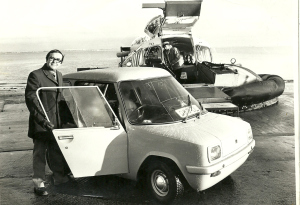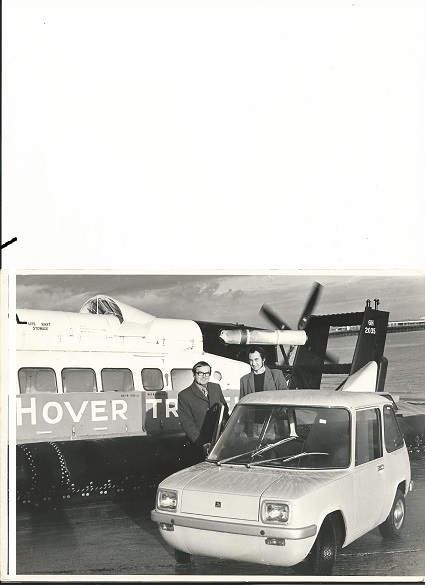Hybrid Cars
Looking back
A hybrid car parked beside me yesterday in the Asda car park. Hybrid vehicles are becoming popular of late but they are not exactly new. I recall travelling in a hybrid car some 50 years ago. At that time I was publicity officer of the battery vehicle society. I worked for British telecom and one of the editorial staff of the British Telecom magazine wrote an article on this. A colleague in one of the other offices read the article and rang me up offering a three-wheeled vehicle which he suggested could be turned into an electric vehicle. I had a look at it and by simply changing the petrol engine for an Electric Motor this could be achieved.
I towed the vehicle to my garage and had decided what I could do. The car concerned was a Nobel 200 three Wheeler of glass fibre construction which consisted of two wheels at the front and one driving wheel at the back. It gave plenty of room for the driver and one passenger. Room for two children in the back. The rather unusual petrol engine was fixed over the rear wheel with a drive chain between the two. The two-stroke engine a differed greatly from any I’d seen before . One electrical unit acted as a starter and as a generator. Being a two-stroke engine it was capable of driving forward or backward. As the driver you could engage three foreword gears, but by turning the ignition key clockwise you drove forward and by turning the key anticlockwise could engage the same three gears backwards. I purchased a lorry starter motor and made plans to replace the engine by this.
I learned that at this time there was a small factory on the isle of Wight producing battery vehicles. I arranged to visit the factory when on a visit to a British telecom telephone exchange. BT Magazine photographers accompanied me on a hovercraft from Portsmouth.
I was met on the beach by the manager of the factory producing the vehicles who then drove me to the factory. The photographs were published in the BT magazine. Soon after I was approached by a reporter from the electrical review magazine who took photographs of my three Wheeler and of two others. Then published an article in the electrical review. I kept in touch with the others and then visited one in Dorset. He had completed a hybrid vehicle as a conversion of a Hillman imp. The vehicle had an engine in the boot at the rear which he had taken out and replaced with an electric motor and velocet motorcycle engine. The velocete motorcycle engine was air-cooled and particularly quiet. He took me as a passenger and I was able to monitor the fuel economy.
JYF 138N: London C.C., 1975
The Industry has also been involved in many demonstration trials of EVs, starting in the 1970s with over 60 prototype Enfield ‘model 8000′ electric cars.
The Greek owned Enfield company branched into low-volume car manufacturing in 1969. The Enfield company had already established itself as a producer of firearms and speed boats and decided to launch a small electric city car, the 8000.
Despite disappointing sales of the electric 8000 which ended in 1971, Enfield experimented with another car, the Safari, in 1972. Alas the model never reached full-scale production and Enfield ceased car production in 1972.
Over a 120 Enfields were built in the early 1970s, mostly for the UK Electricity Council area boards. Responsibility for the original ground-up design is claimed by sir John Samuel. It was born and bred in Wimbledon in 1968. There was a big auction sale in the early eighties at the end of the EC test programme and most of the cars ended up in private collectors’ hands.
There are several still running round in the UK. Dr. David Potter at the Electricity Association is a leading authority on the car, having commuted from home to Basingstoke station for many years. Don Gribble was a great Enfield supporter for a good few years and could probably dig up plenty of history on the cars.
Enfield 465
The Enfield 465 was a small electric car claiming a range of 60 km and a maximum speed of 60 km/h. It was powered by a 4.65-hp motor from a 48-volt lead-acid battery pack. The enclosed body was made of fibreglass and had sliding doors. While prototypes were produced, this particular vehicle does not appear to have seen significant production.
Enfield 8000
The Enfield 8000 was designed from the ground-up to be an electric car. It was produced by Enfield Automotive of London (England) in the mid-1960s. These were 2-door, 4-seater cars with a reported range of 39 to 90 km per charge (depending on driving conditions) and a maximum speed of 64 km/h. The curb weight of the vehicle was 975 kg. It used a tubular steel chassis/frame and aluminum body panels. The motor was connected to a single-speed differential. Reversing the car was accomplished by reversing the drive motor by means of a forward/reverse electric switch on the dashboard. An on-board charger charged both the traction batteries and the accessory battery from any 240-volt, 13-amp outlet (common in Europe). Approximately 70 were purchased by the Electricity Council (England) in 1966 and supplied to electric utilities in England and Wales to demonstrate the practicality of electric cars. Early versions were fitted with 8 x 12-volt traction batteries and a single 12-volt accessory battery. The traction batteries were set up in parallel pairs, with the pairs connected in series to provide 48 volts. Problems with unequal charging and discharging of the parallel pairs resulted in the use of 8 x 6-volt batteries wired as a single series string (still producing 48 volts) being used in later versions of the car. The basic vehicles used a combination of battery switching (12, 24 and 48 volt settings) and field control on the motor to provide speed control. All batteries were in the circuit in all power configurations (to even the discharge).
Electric City Car (prod.: 101 or 103?, 1973-1976 or 1969-1971?)
The Enfield 8000 Electric City Car was built on the Isle of Wight from 1973 to 1976. It was 8 inches shorter than a Mini, had a maximum speed of 37mph and would travel 40 miles on a single charge. Only 100 of these were built.
Coupé, 2 doors, 2 seats, Lead-acid battery, average speed 15,2 km/h.
Then there was the Enfield 8000 which came out in the mid-1970s. It was wonderful, but its batteries weighed a ton, it would only go 40mph and only for 30 miles.
This battery-powered car uses a 10 kW d.c. ‘Lynch’ motor
Controlled by a d.c.chopper in conjunction with a manual 4-speed and reverse gearbox
Six lead acid batteries rated at 165 Ah are used ( 3 in the front and 3 in the back).
The body shell is that of the original ‘Enfield’ electric car and is made from aluminium.
The car is a two-seater and has a range of 35 miles with a maximum speed of 50 mph.
Re-charging using overnight rate electricity costs just a few pence.
To see one in use click the following:
Body: Non-stressed aluminium panels

